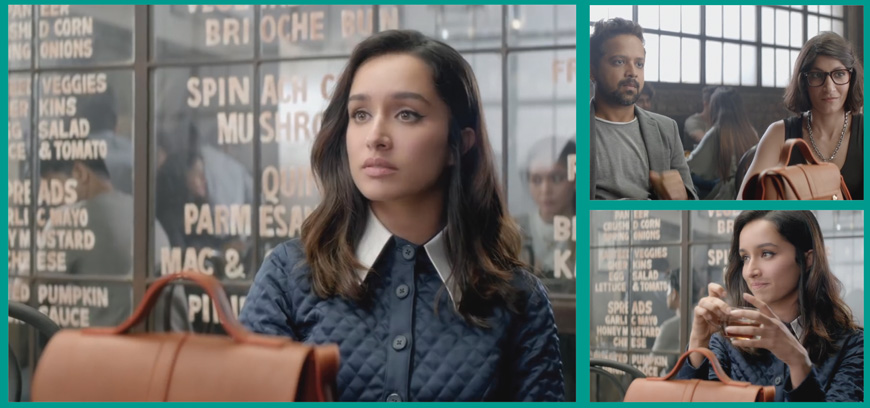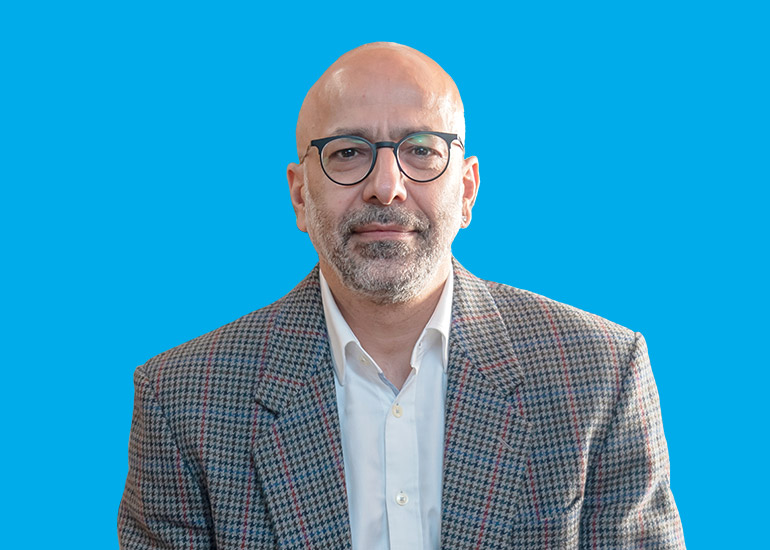Yes, our decision to make her brand ambassador was based on consumer and trade research. We had three options for brand ambassador in mind, and when we analyzed consumer and trade feedback, Shraddha seemed to have everyone’s vote. Moreover, when we even considered her work, and the kind of movies she has signed on, she just seemed like the perfect fit for Baggit. She is inclined to experiment with new ideas, while also staying practical in her approach, which is what makes her truly representative of everything that Baggit stands for. She was also clear that her association with the brand should be a meaningful one, which is why our campaign talks much more than fashion and is not your runof- the-mill fashion brand TVC.
Q] Tell us about the insight behind the latest #PutItOnTheTable campaign.
We considered a lot of subjects we could explore for the campaign, including a pure fashion ad film. However, there was one subject that we were keen to pursue, and that was ‘mansplaining’. The more we explored the subject, the more we realized this was a global concern affecting all women across backgrounds, so why not talk about it? So, our campaign sought to integrate this messaging with the kind of fashion and style that Baggit represents. Our TVC therefore stands for this message, talking to consumers about how gender roles are repressive and that there is no place for gender based power games. The product integrated well with the common phrase ‘put it on the table’, while also emphasizing that everyone should have a right to speak and share opinions.
Q] Increasingly, brands are putting the spotlight on larger, social issues. How does a campaign like this work for your brand?
As a brand, we always go back to the consumers to see how they are evolving and how their needs are changing. This is also reflected in the way we design our products, bearing in mind things like extra pockets for phones, battery chargers, power banks, etc. In everything we do across the value chain from sourcing and designing to our communication and sales, we try to add value to our consumers. So, our latest campaign is not just about riding on a trend, but rather about doing something meaningful, something that actually affects our consumer.
Q] How do you ensure consumers see authenticity in your campaign and do not perceive it as gimmicky?
We don’t want to do something that is a fad or just a new trend. That’s really important for a brand like us. So, even if you look at our Social Media platforms like Instagram, we are developing a lot of content for our consumers in-house. This is to give them a better experience of our product, while also adding to the bigger message of the #PutItOnTheTable campaign. If we do it just to tick boxes off our marketing list, then it is tactical and the consumer can see through it. So we ensure all our content is meaningful, and the response so far is very positive. The responses and appreciation from consumers on Digital towards the new campaign are really humbling

Q] Aside from Digital, what other mediums are you using to reach out to consumers?
The bigger challenge in retail is that the ecosystem is very large, which means we have to reach out not just to the end consumer but all our partners too. We do that through multiple touch points, both Digital and non-Digital. We are present in a lot of malls, so we tie up with them as well. We are talking 1000 counters, so our communication reach is really wide. While we have to adopt a 360 degree execution, Experiential is essential in most of our campaigns. We do multiple small events and consumer engagement activities across malls, where we capture user experiences and showcase them on various platforms, online and offline. Another key element in all our campaigns is influencer marketing.
Q] What is your approach when it comes to influencer marketing?
90% of the influencer associations we do are usually through barter, which means we prefer not to pay and promote our products through influencers. What is really working for us is that several influencers approach us for associations, instead of the other way around. So, we are in a space where we can adopt a pull strategy instead of a push strategy in influencer marketing. This has proven immensely successful for the brand. We believe in our product, and we therefore are rarely forced to pay influencers to write about us.
Q] In an increasingly cluttered space with a plethora of brands, what is Baggit’s strategy to grow market share and stay relevant?
In comparison with physical retail, the online competitive landscape is much wider. There are a lot of new brands entering the market, selling products at lower rates and that is a bit of a challenge. However, our biggest advantage is our core product and our design. Another thing we plan to introduce soon is the system of loyalty points. We have seen old customers come in again and again to make purchases, and that is something we must reward. We also keep our pricing competitive, so that consumers can get a good product without spending ridiculous amounts of money. Perhaps the most important learning is something we have got from Nina (Lekhi), our founder and CEO. She has emphasized the value of actually going to the store and selling to the consumer. There really is so much you can learn from that, in terms of your product and your consumer. It is an excellent practice that helps you leave the competition behind.
Q] What volume of your sales comes from e-commerce?
In the e-commerce space, we sell on Baggit.com and on other online marketplaces such as Amazon and Flipkart. We are looking at a double digit pie as far as online sales are concerned. We also plan to strengthen our own property, Baggit.com because we are certain we could offer the buyer a better experience on our platform. The challenge though is that the consumer shopping online is very different from the offline shopper. So we need to ensure our offering is varied and suited to the online shopper, who is probably browsing multiple styles and designs.
Q] Which markets have performed well for the brand, and which ones do you plan to focus on, going forward?
At any given point of time irrespective of how the business grows, a large chunk always comes from the top ten cities as far as trade is concerned. From Baggit.com, I am actually selling to over 120 cities in India, and that’s a huge number. We see sizable numbers coming from smaller towns like Sikar in Rajasthan, for instance. It is astonishing to see how wide our network has become. Our endeavour is to reach out to consumers in the smallest of towns and give them a great shopping experience with Baggit.
























